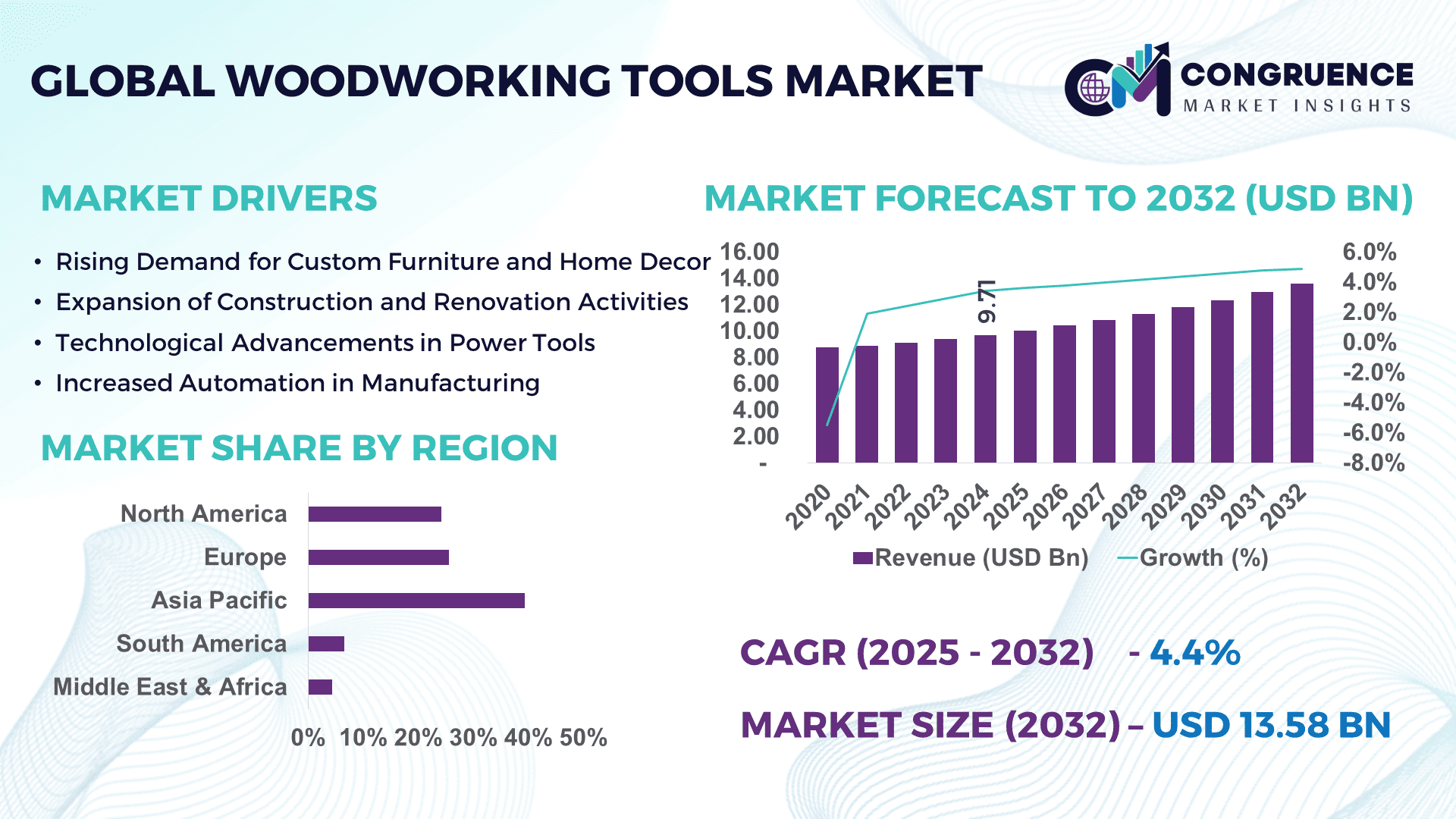Reports
Woodworking Tools Market Report Overview
The Global Woodworking Tools Market was valued at USD 9.71 Billion in 2024 and is anticipated to reach a value of USD 13.58 Billion by 2032 expanding at a CAGR of 4.4% between 2025 and 2032. The major driving forces of the woodworking tools market include rising demand for advanced woodworking equipment as a result of increased house development, renovations, and a growing inclination for DIY projects.

To Learn More About This Report, Request A Free Sample Copy
Woodworking tools are necessary for cutting, shaping, and finishing wood to make furniture, cabinetry, and other wooden goods. The woodworking business has grown dramatically over time, driven by rising demand for high-quality wooden goods. Innovations in tool design and materials have improved the performance, durability, and safety of woodworking tools. The global furniture, interior decoration, and housing markets are expanding, increasing demand for woodworking tools. Industrialization in emerging nations, combined with rising consumer expenditure on home repair, is propelling expansion in the woodworking tools market, making these products essential for both professional craftsmen and hobbyists. Moreover, the expansion of the furniture and interior design industries, as well as the growing interest in custom-made wooden products, all contribute to market growth. Furthermore, technical advances in power tools, which improve efficiency and safety, are driving the growth of the woodworking tools market.
How AI is Transforming Woodworking Tools Market
Artificial intelligence (AI) is starting to transform the woodworking tools market by improving precision, automation, and overall operational efficiency. AI-powered solutions are increasingly being integrated into woodworking gear to automate tasks such as cutting, sanding, and assembly, resulting in shorter production times and less human error. Machines can do difficult jobs with higher accuracy thanks to AI algorithms, reducing material waste and improving quality control. These systems also provide predictive maintenance by evaluating tool wear and performance data in real time, allowing operators to fix issues before they cause costly downtime or flaws in the finished product.
Furthermore, AI is improving the safety of woodworking processes by identifying possible hazards and automatically changing machine operations to avoid accidents. This is especially important in businesses where heavy gear and powerful tools are utilized. The incorporation of AI into woodworking tools increases overall efficiency in workshops and factories, lowers the need for manual labor, and enables businesses to scale up production while maintaining high quality standards. As AI technology advances, its impact on the woodworking tools industry is likely to rise, resulting in new advancements in automation and intelligent woodworking systems.
Woodworking Tools Market Major Driving Forces
· Increasing Demand for Custom Furniture and Home Decor: The growing consumer preference for individualized, high-quality wooden furniture is driving the Woodworking Tools Market. The increased popularity of DIY projects drives up demand for efficient, user-friendly gear.
· Expansion of Construction and Remodeling Activities: With the global increase in house construction and remodeling projects, woodworking tools are becoming more popular for both professional and amateur use, particularly in emerging nations.
· Technological Advancements in Power Tools: Cordless power tools, longer battery life, and improved safety features are pushing the adoption of contemporary woodworking tools, which provide greater ease of use and efficiency.
· Increased Automation in Manufacturing: The use of automated woodworking machines and tools in the furniture and building sectors has considerably increased market productivity and growth.
Woodworking Tools Market Key Opportunities
· Increased Demand for Sustainable Woodworking Practices: As environmental concerns grow, the Woodworking Tools Market recognizes prospects for developing eco-friendly tools and procedures. This includes precise cutting tools, wood waste reduction techniques, and the use of materials sourced responsibly.
· Expansion in Emerging Markets: Rapid urbanization and industrialization in Asia Pacific, Latin America, and Africa create attractive potential for the woodworking equipment market. Rising disposable incomes and increased interest in home remodeling are driving up demand for woodworking tools.
· Technological Integration in Tools: The incorporation of smart technologies and AI into woodworking tools allows manufacturers to differentiate their products by offering improved control, automation, and safety features that appeal to both industrial users and hobbyists.
Woodworking Tools Market Key Trends
· Cordless power tools are becoming more popular in the woodworking tools market, as they provide better mobility, convenience, and efficiency in both professional and personal settings.
· The growing trend of DIY home renovation projects has resulted in increased consumer demand for low-cost, simple woodworking tools, which is driving market expansion.
· Ergonomics and safety are becoming increasingly important to manufacturers when creating products. Features such as vibration control and improved grip are becoming more widespread, particularly with power tools.
· Smart features such as sensors that offer input on tool performance and predictive maintenance, are increasingly being integrated into woodworking tools, enabling for longer tool life and greater safety.
Region-wise Market Insights
Asia Pacific accounted for the largest market share at 39.4% in 2024 moreover, Asia Pacific is also expected to register the fastest growth, expanding at a CAGR of 4.8% between 2025 and 2032.

To Learn More About This Report, Request A Free Sample Copy
In 2024, Asia Pacific occupied the largest share in the Global Woodworking Tools Market. The region is also predicted to experience the strongest development, with a CAGR of 4.8% between 2025 and 2032. Rapid urbanization, increased industry, and expanding demand for customized wooden items in China, India, and Japan are driving the expansion. The region's thriving building industry, combined with the growing popularity of DIY projects, is driving market demand even higher.
· In January 2025, Bosch Power Tools launched a new brand campaign, "The More You Bosch, The More You Feel Like a Bosch," alongside the release of 15 new tools and accessories. The campaign highlights the brand's focus on empowering DIY enthusiasts and professionals through innovative power tool solutions. The new products include advanced tools designed for greater efficiency, durability, and performance, enhancing the overall user experience.
North America controls a sizable portion of the market due to the existence of modern manufacturing businesses and a growing trend of home remodeling. The region benefits from technology developments in power tools and the appeal of custom furniture, particularly in the United States and Canada.
Europe is also a significant market, with expanding demand for woodworking tools driven by increased residential remodeling activities, particularly in Germany, France, and the United Kingdom. The European market is increasingly focused on sustainability and environmentally responsible woodworking processes.
Recent Developments
· In November 2024, DeWalt launched its PowerShift system, a revolutionary cordless platform for electric construction tools, now available across North America. This system provides construction professionals with enhanced power, durability, and mobility, eliminating the need for traditional gas-powered tools. PowerShift supports a variety of heavy-duty applications and boosts efficiency on job sites by offering longer runtimes and fast charging capabilities.
· In August 2024, Festool introduced its ExoActive exoskeleton, designed to reduce fatigue and increase productivity for professionals in the woodworking industry. The exoskeleton supports upper body muscles, helping workers with overhead tasks and physically demanding activities. This innovation is aimed at enhancing comfort and long-term health by minimizing strain during intensive work.
· In May 2022, Makita announced the addition of 19 new XGT cordless tools and equipment to its expanding system. The XGT system is designed to deliver high power and performance while maintaining the convenience of cordless technology, suitable for demanding applications. The new tools include equipment such as demolition hammers, impact drivers, and chainsaws, enhancing the variety and versatility of the XGT platform.
Market Competition Landscape
The global woodworking tools market is extremely competitive, with established players and emerging competitors vying for market share. Major firms seek to strengthen their market positions through product innovation, sustainability, and mergers and acquisitions. Leading businesses are investing in innovative technologies such as AI, automation, and smart tools to address the changing needs of both the professional and consumer sectors.
Key companies also prioritize ergonomics, safety features, and energy-efficient designs in response to rising consumer demand for user-friendly and environmentally friendly products. The advent of DIY culture has encouraged companies to release more affordable and accessible woodworking tools, thereby catering to a larger audience.
Key players in the global woodworking tools market implement various organic and inorganic strategies to strengthen and improve their market positioning. Prominent players in the market include:
· Bosch Power Tools
· Stanley Black & Decker
· Makita Corporation
· DeWalt
· Hikoki Power Tools
· Festool
· Milwaukee Tool
· Skil Power Tools
· Einhell Germany AG
· Metabo
· Ryobi Limited
· C. & E. Fein GmbH
· Apex Tool Group
· Hilti AG
|
Report Attribute/Metric |
Details |
|
Market Revenue in 2024 |
USD 9.71 Billion |
|
Market Revenue in 2032 |
USD 13.58 Billion |
|
CAGR (2025 – 2032) |
4.4% |
|
Base Year |
2024 |
|
Forecast Period |
2025 – 2032 |
|
Historical Data |
2020 to 2024 |
|
Forecast Unit |
Value (US$ Bn) |
|
Key Report Deliverable |
Revenue Forecast, Growth Trends, Market Dynamics, Segmental Overview, Regional and Country-wise Analysis, Competition Landscape |
|
Segments Covered |
· By Product Type (Hand Tools, Power Tools, and Accessories) · By End-Use (Industrial and Commercial) · By Mode of Operation (Manual, Electric, and Pneumatic) · By Sales Channel (Online and Offline) |
|
Geographies Covered |
North America: U.S., Canada and Mexico Europe: Germany, France, U.K., Italy, Spain, and Rest of Europe Asia Pacific: China, India, Japan, South Korea, Southeast Asia, and Rest of Asia Pacific South America: Brazil, Argentina, and Rest of Latin America Middle East & Africa: GCC Countries, South Africa, and Rest of Middle East & Africa |
|
Key Players Analyzed |
Bosch Power Tools, Stanley Black & Decker, Makita Corporation, DeWalt, Hikoki Power Tools, Festool, Milwaukee Tool, Skil Power Tools, Einhell Germany AG, Metabo, Ryobi Limited, C. & E. Fein GmbH, Apex Tool Group, Hilti AG |
|
Customization & Pricing |
Available on Request (10% Customization is Free) |
